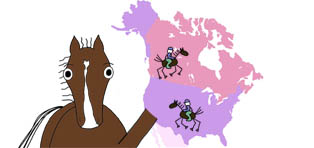LosAltosOnline.com - Full Article
25 October 2017 Written by Sarah Feng - Town Crier Editorial Intern
Jody Wyatt competes in an endurance sport that requires help from a four-legged friend.
Five to six days a week, she and her 11-year-old daughter, Leyla, rigorously train with their horses in open space preserves, often in Los Altos Hills. They do this to improve their endurance riding – an equestrian sport that requires riding horses anywhere from 5 to 100 miles over difficult terrain.
Because of the sport’s demanding and often dangerous nature, intense training is necessary to create a strong bond between the rider and the horse. According to Wyatt, trust is imperative.
Wyatt’s three years of training recently culminated in the 100-mile Tevis Cup. She and her horse, Amira, finished in 23 of the 24 allotted hours. Out of 175 starters, the pair was among 50 to finish the ride across Squaw Valley to Auburn.
The connection between Wyatt and Amira was crucial to their success.
“I think Amira knew that she was at Tevis, that it was a unique ride and that it was her time to take care of me,” the former Palo Alto resident said...
Read more here:
https://www.losaltosonline.com/news/sections/sports/198-features-sports/56392-
Wednesday, October 25, 2017
Saturday, October 21, 2017
Wild Horse & Burro Advisory Board - Oct. 19, 2017
 Facebook.com
Facebook.comBEN MASTERS
THURSDAY, OCTOBER 19, 2017
I sit as the Wildlife Management Chair on the Bureau of Land Management’s Wild Horse and Burro Advisory Board. My responsibility is to represent the interests of wildlife on 30 Million acres of public land in the American West as they are affected by Wild Horses and Burros. That is an area the size of nearly 15 Yellowstone National Parks. I’m honored to have been nominated to sit in the unpaid volunteer position and I take it very seriously. It is a tremendous responsibility in a truly tragic situation.
Simply put, the Wild Horse and Burro Program is a complete wreck. It is a toxic, ugly, finger-pointing, emotional, and controversial subject that for decades our society, politicians, the BLM, and congress have failed to enact a sustainable management plan to avoid a large and looming ecological disaster. Right now there are over 3X the target population of Wild Horses and Burros nationwide and in some areas they are causing severe ecological damage. In other areas, they aren’t. History and common sense tells us that when a population exceeds its carrying capacity in a confined area with limited resources, there is a population crash. When those population crashes occur, it affects all the wildlife in an area along with vegetation, soil, water quality, etc… Much worse than the population crash are the long-term effects, especially in desert environments, where native plant communities can take decades or centuries to grow back. In arid deserts of the Great Basin where most wild horses roam, disturbed native plant communities are often replaced by fire-prone annual invasives, especially cheat grass, that can dominate a landscape. An estimated 50 million acres of the American West has already been converted into an invasive cheatgrass monoculture and as a society, I believe we should direct our land managers to put ecosystem health as #1 top priority. Some of the ecological degradation could be permanent and may never recover in our lifetime. The very worse case scenario for Wild Horses and Burros, your public land that they depend on, and all the wildlife that require that habitat, is to take a no-management approach when it comes to wild horses and to allow nature to take its course.
Today I supported the recommendations brought by the Advisory Board that allows for a lethal management of the wild horses and burros. Already, a mere two hours after the meeting, there have been multiple organizations directing social media hate mail towards me and my pages. If you’re one of those people who came to this page wanting to hate me, I understand. Please take the time to read the rest of this post and I would love to hear your thoughts about how to create a sustainable path forward. Unfortunately, I don’t see one and I have studied this issue extensively. This is a hard pill for me to swallow because for the past several years of my life I’ve tried to find a solution to the Wild Horse & Burro dilemma that got every single horse adopted. I’ve adopted numerous mustangs personally, have helped make multiple films promoting adoptions, and have raised over $100k for wild horse adoption organizations. I’ll try to explain how this situation has spun so out of control and why I made the recommendations that I did.
The Ancestors of Wild Horses evolved in North America and went extinct in the Great Pleistocene Extinction around 10,000 years ago. Fortunately, they migrated across the Bering Strait prior to extinction where they were eventually domesticated, breeds developed, artificial selection occurred, and horses were ultimately brought back to the Americas during European Expansion. Horses escaped, were set free to breed, and multiplied in a “Wild” or “Feral” state for hundreds of years. As the West was settled, these Wild Horses, often called mustangs, were rounded up to the point that Velma Johnson, AKA Wild Horse Annie, pushed for legislation to protect the remaining Wild Horses. This culminated in the Wild and Free Roaming Horse and Burro Act of 1971 that protected the 15,000 or so Horses and Burros remaining in the American West. Today Wild Horses and burros are managed on about 30 million acres of land in about 179 Herd Management Areas (HMAs).
Under protection, the Wild Horses and Burro populations grew about 15-20% annually and threatened overgrazing on the rangelands that they shared with wildlife and in some cases livestock. So the BLM, the government agency in charge of managing the Wild Horses, created Appropriate Management Levels (AMLs) which is the number of horses that each Herd Management Area (HMA) can supposedly sustain in a thriving ecological balance with wildlife and in some areas livestock. Currently, the nationwide AML is 27,000.
While the Appropriate Management Level is 27,000, the current population is estimated to be between 80,000-85,000 Wild Horses and Burros (including 2017 foals) which is over 3X the target population. For reference, when I first became involved in the WH&B issue there were less than 50,000 in the wild. The BLM is supposed to gather excess horses to prevent overgrazing but they can’t because they don’t have a place to put them because they’ve already gathered and are boarding 45,000 Wild Horses and Burros in feed lot-style holding pens and leased pasture. The BLM is spending $50 Million annually (2/3 of its Wild Horse and Burro budget) to feed these horses in holding. Each individual horse that goes into the holding pen process is estimated to cost taxpayers $50,000 per individual. For the price of all the horses being kept in holding pens, you could send 90,000 students to an in state 4-year college. To me, that level of government spending is completely unacceptable. That is why I made the recommendation to: “Phase out long-term holding over the next three years and apply that budget to on-range management and adoptions.” This recommendation passed the board 6-1. To phase out Long Term holding, the public would have the opportunity to adopt the horses and acquire the ownership and expenses involved.
Unfortunately, the horse market is saturated, many rescue facilities are full to the brim, and adoption has fallen over the past decade. If the public didn’t adopt them all, it’s possible some non-reproducing herds could be established on public lands. Most likely, some horses would have to be euthanized. This is not a crazy thought. People euthanize millions of dogs and cats every year, Bison are culled in Yellowstone to prevent overgrazing, and Elk are culled in Rocky Mountain National Park. It’s not a fun topic to discuss so I’ll move on...
Read more here:
https://www.facebook.com/notes/ben-masters/wild-horse-burro-advisory-board-oct-19-2017/1769325596697949/
Susan Anderson institutes The Iron Horse Challenge endurance race
AnzaVelleyOutlook.com - Full Article
By Diane Sieker on October 21, 2017
Local resident Susan Anderson is most recently well-known for her secret passion for art as the Anza Phantom Artist, having secretly painted and placed large colorful road signs all over the area. Besides being a vet and avid horsewoman, she recently organized and hosted a local equestrian event, The Iron Horse Challenge, which was held Sept. 23 and 24.
The Iron Horse Challenge was an “endurance race” and involved testing both rider and animal to the extremes without causing detrimental harm to either one. Vet techs were on hand during the event to check the well-being of the horses. Water and other essentials were provided at intervals during the competition. Generally, endurance races range from five or 10 miles to hundreds of miles long.
“I got involved with endurance back in 1991, when I lived in Northern California and became friends with Bobbie Haskall, who put on a ride every six months up at Whiskeytown Lake by Redding,” Anderson said. “First, I started vetting the rides for her, then I bought one of her horses and competed briefly. My first ride was a 50-mile ride, and I came in ninth out of 65 riders, I believe. What a kick! I was amazed and inspired. I have always loved this sport. It is lot more regulated and complex than people think, and when done properly is a wonderful example of how people and horses can work together to achieve amazing things...”
Read more here:
http://anzavalleyoutlook.com/local/susan-anderson-institutes-iron-horse-challenge-endurance-race/
By Diane Sieker on October 21, 2017
Local resident Susan Anderson is most recently well-known for her secret passion for art as the Anza Phantom Artist, having secretly painted and placed large colorful road signs all over the area. Besides being a vet and avid horsewoman, she recently organized and hosted a local equestrian event, The Iron Horse Challenge, which was held Sept. 23 and 24.
The Iron Horse Challenge was an “endurance race” and involved testing both rider and animal to the extremes without causing detrimental harm to either one. Vet techs were on hand during the event to check the well-being of the horses. Water and other essentials were provided at intervals during the competition. Generally, endurance races range from five or 10 miles to hundreds of miles long.
“I got involved with endurance back in 1991, when I lived in Northern California and became friends with Bobbie Haskall, who put on a ride every six months up at Whiskeytown Lake by Redding,” Anderson said. “First, I started vetting the rides for her, then I bought one of her horses and competed briefly. My first ride was a 50-mile ride, and I came in ninth out of 65 riders, I believe. What a kick! I was amazed and inspired. I have always loved this sport. It is lot more regulated and complex than people think, and when done properly is a wonderful example of how people and horses can work together to achieve amazing things...”
Read more here:
http://anzavalleyoutlook.com/local/susan-anderson-institutes-iron-horse-challenge-endurance-race/
Sunday, October 15, 2017
Nomination Time for Distance Horse of the Year Award
October 13, 2017
The Nomination Deadline is Approaching Fast for Distance Horse of the Year Award
The Distance Horse of the Year Award is presented to an Arabian, Half-Arabian or Anglo-Arabian horse for outstanding achievements in distance events for the current year. The award recipient is honored by a name plate on the perpetual trophy and listed on the Arabian Horse Association's (AHA) website.
In addition, the owner of the horse receives a take-home trophy to display. The winner of the award will be chosen at AHA's Annual Convention.
Anyone may nominate a horse for this award by filling out the nomination form and submitting it by November 1. The owner of the horse must be a current AHA member with a Competition Card. To view previous Distance Horse of the Year award winners, click here.
You can download the Nomination form here. Forms can be submitted by fax to (303) 696-4599, emailed to Devin Smith at devin.smith@arabianhorses.org, or mailed to the following address:
Arabian Horse Association
C/O Devin Smith
10805 E Bethany Dr.
Aurora, CO 80014
The Nomination Deadline is Approaching Fast for Distance Horse of the Year Award
The Distance Horse of the Year Award is presented to an Arabian, Half-Arabian or Anglo-Arabian horse for outstanding achievements in distance events for the current year. The award recipient is honored by a name plate on the perpetual trophy and listed on the Arabian Horse Association's (AHA) website.
In addition, the owner of the horse receives a take-home trophy to display. The winner of the award will be chosen at AHA's Annual Convention.
Anyone may nominate a horse for this award by filling out the nomination form and submitting it by November 1. The owner of the horse must be a current AHA member with a Competition Card. To view previous Distance Horse of the Year award winners, click here.
You can download the Nomination form here. Forms can be submitted by fax to (303) 696-4599, emailed to Devin Smith at devin.smith@arabianhorses.org, or mailed to the following address:
Arabian Horse Association
C/O Devin Smith
10805 E Bethany Dr.
Aurora, CO 80014
Friday, October 13, 2017
AERC: Time to Join or Renew!
AERC.org
"LAST CALL FOR FALL" SPECIAL! Haven't renewed or joined yet but going to a ride or two before the season ends? Renew or join by Oct. 30 and be entered into our drawing for a chance to win an awesome #aerc package!
Winner receives one of our popular "Don't Saddle For Less" t-shirts, an AERC picnic blanket, and an AERC swag bag! There are lots of rides left in the season! Open to new AND renewing members.
Easy link to join/renew: https://aerc.org/Join_AERC
"LAST CALL FOR FALL" SPECIAL! Haven't renewed or joined yet but going to a ride or two before the season ends? Renew or join by Oct. 30 and be entered into our drawing for a chance to win an awesome #aerc package!
Winner receives one of our popular "Don't Saddle For Less" t-shirts, an AERC picnic blanket, and an AERC swag bag! There are lots of rides left in the season! Open to new AND renewing members.
Easy link to join/renew: https://aerc.org/Join_AERC
Thursday, October 12, 2017
Young Rider Team Challenge
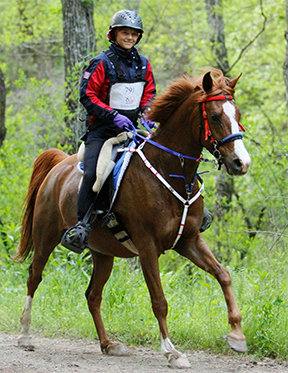 (photo: Tessa Kimbler)
(photo: Tessa Kimbler)With only a month to go, the AERC Young Rider Team competition is fired up. AERC's Young Riders (aged 16 - 21) formed 5-member teams early in the 2017 ride season, with competition points earned by each individual to be tallied for a team score.
For more information on the Young Rider Team Challenge, visit the website: http://endurance.net/youngriderteam/
It's not too early to be thinking about next season!
Here are the team scores to date:
1) Southern Reins- 574.5
2) MW/Aussie Exchange Riders- 568.25
3) Northern Lights- 526.25
4) Hot to Trot Trixies- 425.25
5) NE Endurance Divas- 387
The following is a list of the members of each team:
Southern Reins
Hannah Crenshaw
Abbey Crenshaw
Abbey Kay Moore
Caroline Guy
Annie Whelan
Hot To Trot Trixies
Ragan Kelly
Haley Moquim
Windsor Mundy
Eilish Connor
Kayloni Carrol
Northern Lights
Solstice Pecile
Mackanzie Coffey
Rhyne Maas
India Orino
Cali Orino
NE Endurance Divas
Maria Muzzio
Amelia Young
Kelsie Lewis
Hanna Weightman
Sarah Buckley
MW/Aussie Exchange Riders
Tessa Kimbler
McCamey Kimbler
Charlie Koester
Lexi Vollman
Tahlia Franke
Wednesday, October 11, 2017
2017 Arabian Horse Association Distance Nationals/Owyhee Canyonlands
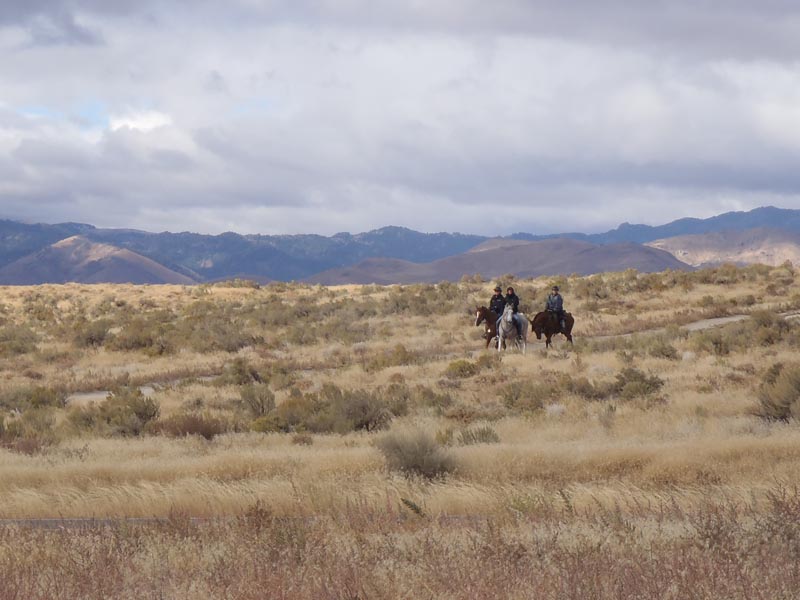
October 11 2017
by Merri Melde-Endurance.net
Endurance riders, Arabian Horse Association people, Two Trees catering by the fabulous Wynne Teeter, evening jams, an even better band, Country Club (classic country, honky tonk, old time, and bluegrass, starring Steph's fiddle teacher), the local Radio Club (who came in very handy when a rider was injured out on trail), and the stars of the show, the endurance horses, merged and mingled at the Teeter Ranch the weekend of October 6-8 for the 3-day Owyhee Canyonlands/AHA Distance Nationals.
Not only did the Arabian Horse Association hold their 50-mile and 100-mile Purebred Arabian, and Half-Arabian/Anglo Arabian Championships, but they also hosted the Appaloosa 50-mile Championship (ANCER) and the Paso Fino National Championship. The Teeter Ridecamp looked like Days of Old, when trailers squeezed into every conceivable space both in front and in back.
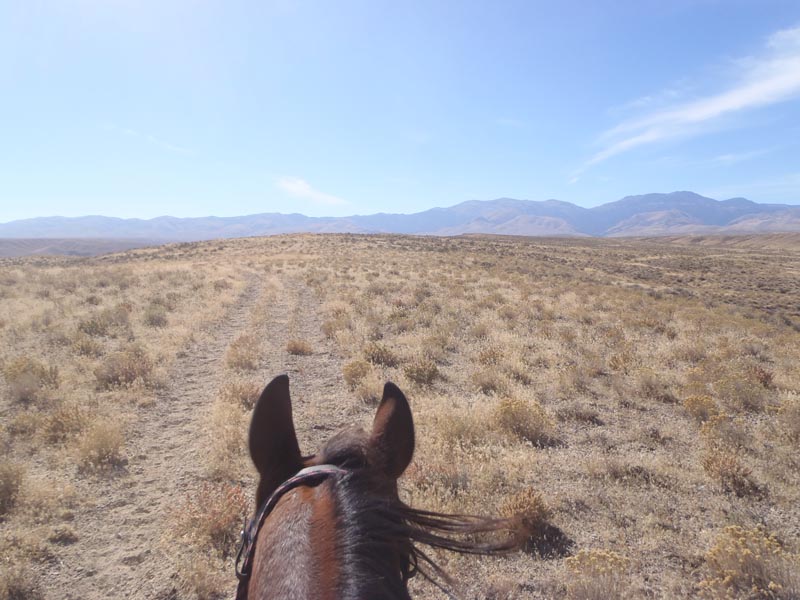
While more horse trailers continued to pull into camp on Friday, the Day 1 25-mile ride and the AERC 50-mile ride took riders into the Owyhee desert, down to the Snake River and around Wild Horse Butte.
39 riders started the 50, with 36 finishing. Winner was Christoph Schork, riding RR Jazz Dancer in 5:13. Daneila Lambeck was second (also 5:13) aboard Christoph's GE Berry Haat Salza. Karen Steenhof and WMA Proclaim came in third in 5:50. GE Jazz Dancer won Best Condition.
20 started the LD, with 15 finishing. Vonnie Brown aboard Chipikiri won the ride in 4:04, a minute over Leonard Bottleman and APP Taylor La Esplendida Mirada. Bill Miller, riding Tezeros Annie Sue, and David Brown, riding Tezeros Hot Shot, finished third and fourth in 4:10. Tezeros Hot Shot got Best Condition.
Day 2 was a busy ride day, with a 25-mile LD, an open 50-mile ride, and the 4 50-mile Championship rides: Purebred Arabian, Half-Arabian/Anglo-Arabian, Appaloosa, and Paso Fino.
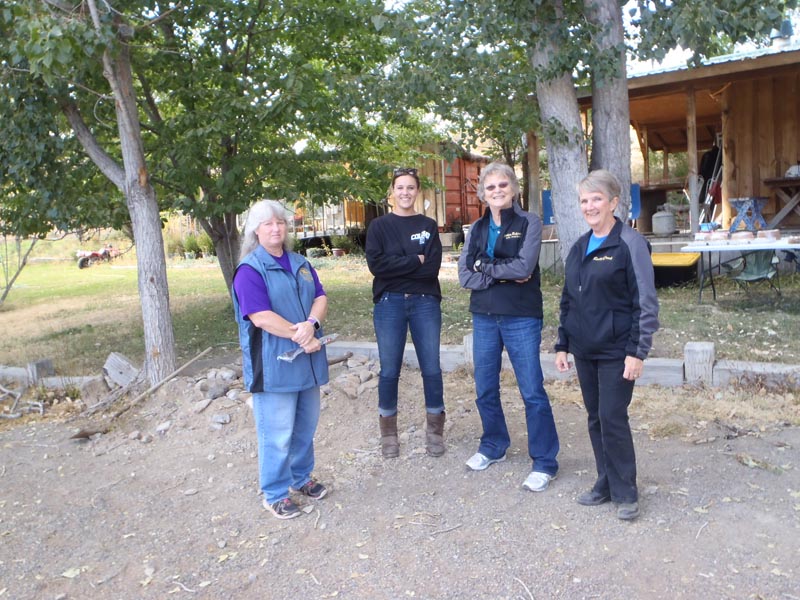
14 riders started the AHA Purebred Arabian Championship, with 12 finishing. John Stevens, from Lincoln, California, took the Championship honors with his 9-year-old gelding Rabbalad (FV Classic Farwa x FV Farabba, by Haji Rabba) in 5:08. Reserve Champion went to Christoph Schork, from Moab, Utah, aboard GE Haat Rod Express (DWA Express x Pico Stardust +/, by Pico Haat Shaat) in 5:33. Jeff Stuart, from Ogden, Utah, took third with JV Remington (JV Shadow Dancer x Sugar is Fine, by *Patriark) in 6:27. GE Haat Rod Express won Best Condition.
7 riders started the Half-Arabian/Anglo Arabian division, with 5 finishing. Jeff Loe from Trail, Oregon, and Hillcreek Pyra (SFF Pyro x Zephyr) won in a time of 6:27. Denise Obray, from Auburn, California, and TM Dunit in Gold (Ima Dun Kid x Faireshine Padron, by *Padron) finished second in 7:06. Junior rider Sarah Holloway from Maple Valley, Washington, finished third aboard Phinneas (Grandson of the Black Stallion) in 8:28. Phinneas won the Best Condition award, much to his approval.
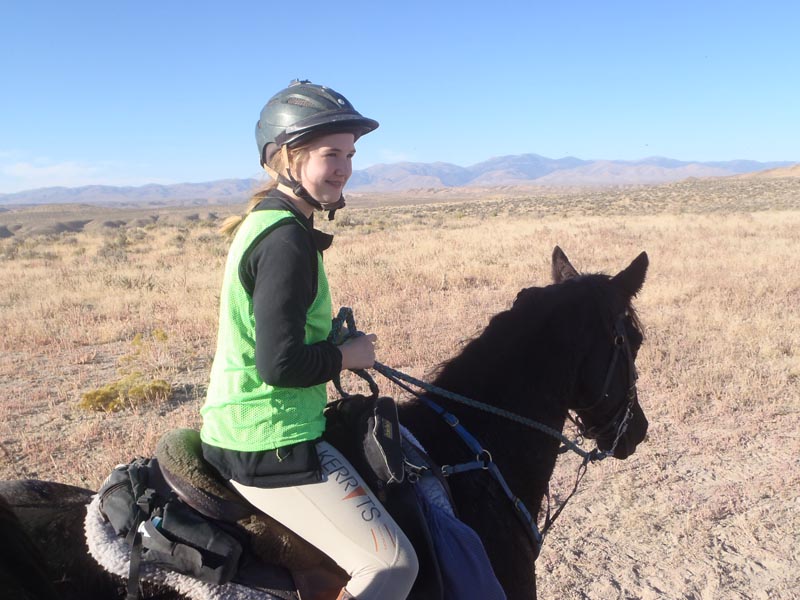
Top honors in the Appaloosa Championship went to Siri Olson from The Dalles, Oregon, and EZ To B Perfect, in a ride time of 7:52. Jessica Cobbley, from Blackfoot, Idaho, and The Big Brass finished second in 7:58. Third place went to Kathleen Jepson, from Independence, Oregon, aboard Spotted Wap in a ride time of 8:21. EZ To B Perfect also won Best Condition. 6 started and 4 completed the ride.
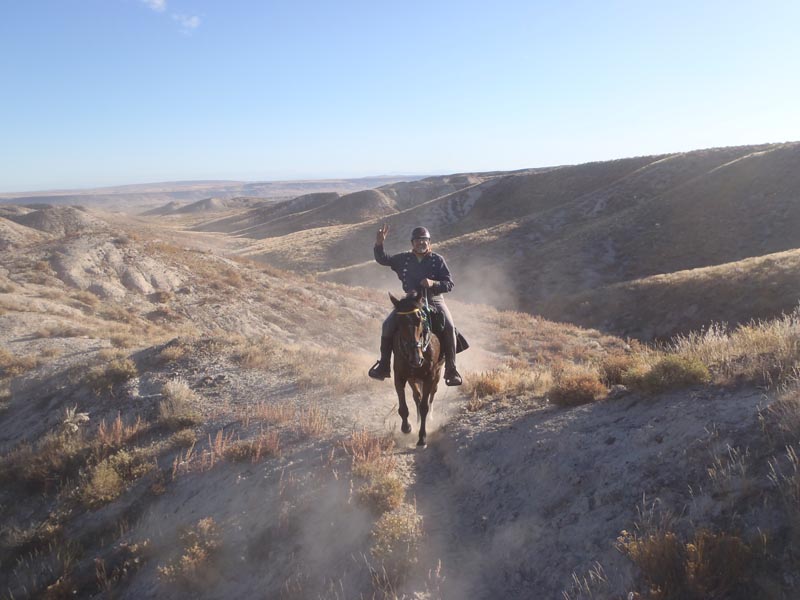
The Paso Fino Championship had 3 starters and finishers. Chris Cane, from Olympia, Washington, and Marco del Padre finished first in 8:59, and earned the Best Condition award. Lindsay Campbell, visiting from Lake City, Florida, finished second aboard Cane's horse Magico del Padre in 9:00. The current AERC President, Paul Latiolais, from Milwaukie, Oregon, finished third aboard Francisco Adan CuGR in 10:13.
50 riders started the Open 50 mile ride, with 41 finishing. John Stevens and Rabbalad were first in 5:08. Christoph Schork and GE Haat Rod Express were second in 5:33, and Dean Hoalst and Redwing Ofcourage finished third in 5:56. GE Haat Rod Express won the open AERC Best Condition award.
The Racing Mules put on their fun and excellent show in the LD (3 of them carrying Juniors). They took the top 4 spots, with Junior Parker Eversole and out of Idaho winning in 3:10, with sponsor Trinity Jackson aboard Gracie second (also in 3:10). Junior Sidney Jackson was third on Bear in 3:11, and Junior Lucy Martin was fourth on Irish in 3:12. 8th place Stace Moss aboard Top Hat Frost won Best Condition. 20 started and 18 finished the ride.
Day 3 saw a 25-mile ride, an open 55-mile ride, and the 100-mile open, Purebred Arabian, and Half-Arabian/Anglo Arabian Championships. The 100-milers got to visit Wild Horse Butte, the Snake River, and one of the more scenic canyons in the area, Sinker Creek, which runs through the historic 150+-year-old Joyce Ranch.
All participants this day, horses, riders, and volunteers, got the added bonus of cold gale winds, which were actually acceptable, because they blew the gnats into the next county. It was fine 100-mile horse weather, reflected by the most excellent high completion rates, particularly in the 100.
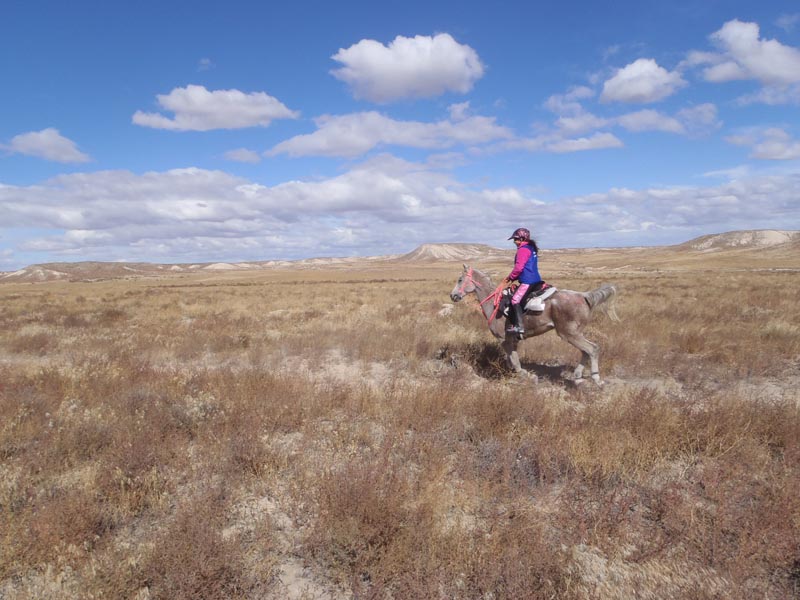
"Team Stevens," from Lincoln, California, and their sleek Purebred Arabians were the stars of that 100-mile division. Crossing the finish line in 8:57 were Diane (first place) aboard the 15-year-old gelding Banderaz LC7 (Jazzman DGL x Zordosa, by *Bandos PASB), and John (second place) aboard the 9-year-old gelding Justin SF (Sir Fames HBV x NNL Just a Heat, by Don El Chall). Justin SF won the Best Condition award. Third place went to Jeanette Mero, of Mariposa, California, and Jet Setting Sandrita (Djet Set De Falgas x Tiki Destiny, by Sambors Destiny) in 10:40. Jeanette rode and finished with her 16-year-old Junior daughter Reyna, aboard Triomphe. This made the Team Mero weekend a complete success (they also finished the AHA 50 the day before), after 2 breakdowns on the way to Idaho and arriving at camp in the middle of the night. The AHA finish made 4 100-mile completions for both horses for the year.
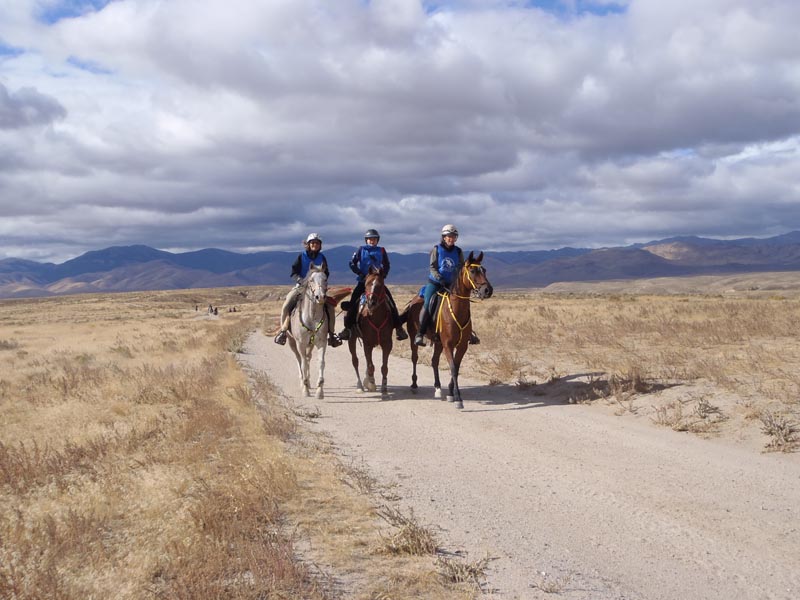
The only other Junior in the AHA Purebred ride was 14-year-old Sarah Holloway, of Maple Valley, Washington, riding with her aunt Connie Holloway aboard DWA Saruq. Sarah and her 14-year-old gelding Noble Desperado finished in 13th place in a ride time of 15:40 in their first 100-mile ride. 15 started and 14 finished the ride.
A literal coin toss determined the winner of the Half-Arabian/Anglo Arabian 100-mile Championship, because they could not be separated by a nostril wrinkle or a tail hair at the finish. Winner was Suzanne Hayes, of Arlee, Montana, riding her 9-year-old half-Thoroughbred gelding Sanstormm (Sanskrit x Alta Snow), in a time of 9:45. Reserve Champion was Christoph Schork aboard the half Quarter horse mare GE Pistol Annie (Sulte x Sissy). Annie won the Best Condition award. Third place out of 3 starters went to Carson City, Nevada's Connie Creech aboard LS Steele Breeze (Remington Steele x LS Shareem, by Luzero), in a ride time of 15:07. This was Breezy's 16th 100-mile completion. Her previous ride was a finish in the tough Virginia City 100 three weeks earlier.
The open AERC 100-mile ride had 26 starters and 23 finishers. Diane and John Stevens tied for first, and Christoph Schork and Suzy Hayes tied for third place along with Meridian, Idaho's Lynn Rigney, aboard Predictable. That pair also finished the Virginia City 100 three weeks earlier, in 6th place. Justin SF won the open Best Condition award.
10 riders started the 50-mile ride, with 8 completing. First place went to Jeff Stuart and DWA Malik in a ride time of 6:30. Tani Bates and CR Marjan Roars were second in 6:35, and Beth Nicholes and DWA Zifhaffir were third in 7:08. Best Condition went to DWA Zifhaffir.
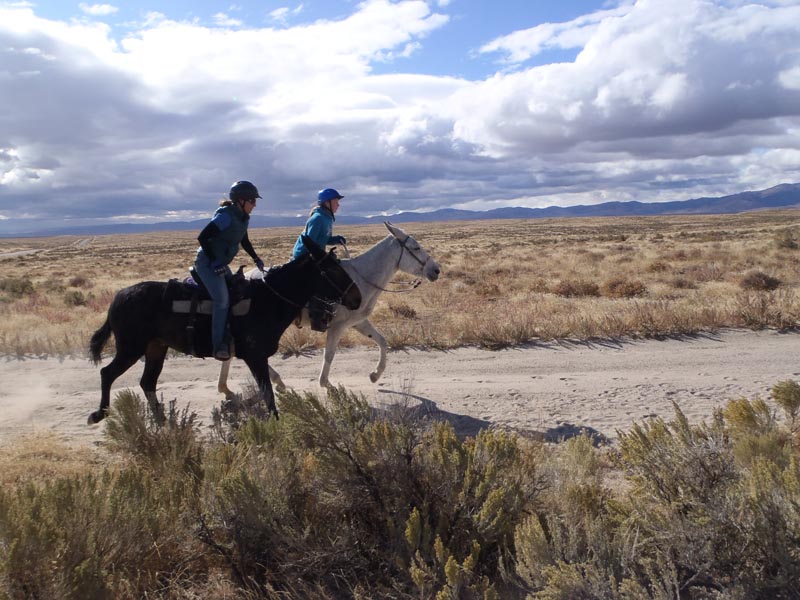
All 19 starters finished the LD ride (5 mules again!), with Bill Miller finishing first in 2:41 aboard Raffons Noble Dancer. Second was David Brown aboard Tezeros Hot Shot. The 5 mules were next, carrying 3 Juniors. Tezeros Hot Shot won Best Condition.
For more photos and stories on the ride, see:
www.endurance.net/international/USA/2017AHAOwyheeCanyonlands
Monday, October 09, 2017
Team Stevens Dominates 2017 Arabian Horse Association Distance Nationals Purebred 100 Mile Ride
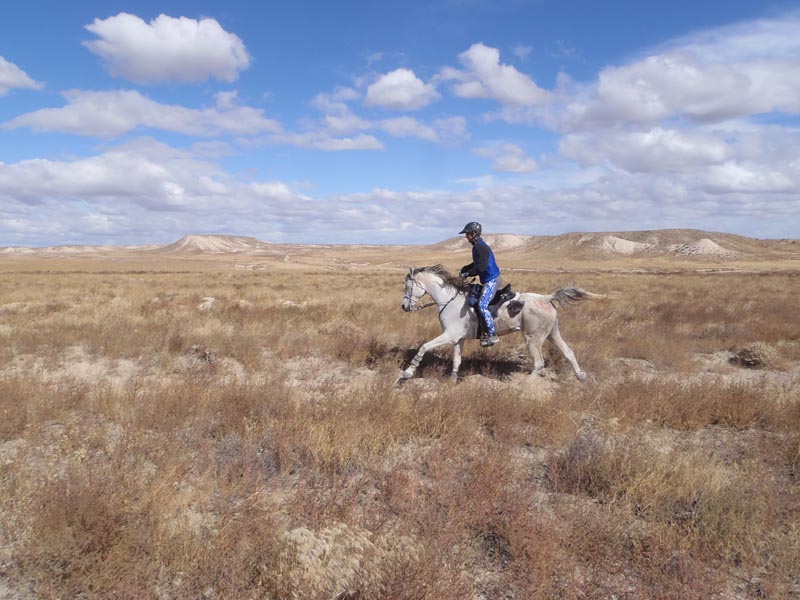
by Merri Melde-Endurance.net
October 9 2017
The wife and husband team of Diane and John Stevens, from Lincoln, California, took top honors in the AHA Distance Nationals Purebred Arabian 100 Mile ride in Oreana, Idaho on Sunday October 8th.
Diane and her gelding Banderas LC7 took first place in a ride time of 8:57. John and his gelding Justin SF took second place (also ride time of 8:57), and, next morning, the Purebred Best Condition award. 15 started the division with 14 finishing.
Winner of the AHA 100-mile Half Arabian/Anglo Arabian division was literally determined on a coin toss. Suzanne Hayes, from Arlee, Montana, aboard Sanstormm tied with Christoph Schork, from Moab, Utah, aboard GE Pistol Annie right on the finish line with a ride time of 9:45. A coin toss gave the win to Suzy Hayes. Christoph's GE Pistol Annie won the Best Condition award the next morning. Connie Creech and LS Steele Breeze finished third in a ride time of 15:07, making 3 starters and 3 finishers in this division.
More to come at:
www.endurance.net/international/USA/2017AHAOwyheeCanyonlands
Sunday, October 08, 2017
2017 Arabian Horse Association Distance Nationals 50 Mile Winners
 www.endurance.net/international/USA/2017AHAOwyheeCanyonlands
www.endurance.net/international/USA/2017AHAOwyheeCanyonlandsOctober 8 2017
by Merri Melde-Endurance.net
The 50-mile Arabian Horse Association Distance National 50-mile ride was held Saturday October 7 at the Teeter Ranch in Oreana, Idaho.
Winner of the Purebred Arabian division was John Stevens, of Lincoln, California, aboard Rabbalad in a time of 5:08. Second place went to Christoph Schork, of Moab, Utah and GE Haat Rod Express in 5:33. Jeff Stuart, from Ogden, Utah, was third aboard JV Remington in 6:27. GE Haat Rod Express won Best Condition. 14 started the ride with 12 completing.
In the Half-Arabian/Anglo Arabian division, Jeff Loe from Trail, Oregon, and Hillcreek Pyra won in a time of 6:27. Auburn, California's Denise Obray and TM Dunit in Gold finished second in 7:06, and Junior rider Sarah Holloway from Maple Valley, Washington, finished 3rd aboard Phinneas in 8:28. Phinneas won the Best Condition award. 7 started and 5 finished the ride.
Held in conjunction with the Arabian Distance National were the ANCER (Appaloosa National Championship Endurance Ride) and PFHA (Paso Fino Horse Association) 50 mile championships.
6 started and 4 completed the ANCER Championship. Siri Olson from The Dalles, Oregon, and EZ To B Perfect won first place and Best Condition in a ride time of 7:52. Jessica Cobbley, from Blackfoot, Idaho, and The Big Brass finished second in 7:58. Third place went to Kathleen Jepson, from Independence, Oregon, aboard Spotted Wap in a ride time of 8:21.
3 started and finished the PFHA Championship, with Chris Cane, from Olympia, Washington, and Marco del Padre finishing first and winning Best Condition in a ride time of 8:59. Lindsay Campbell, from Lake City, Florida, finished second aboard Cane's horse Magico del Padre in 9:00. Paul Latiolais, current AERC President, from Milwaukie, Oregon, finished 3rd aboard Francisco Adan CuGR in 10:13.
The 100 Mile Championship is being held Sunday October 8.
More information at:
www.endurance.net/international/USA/2017AHAOwyheeCanyonlands
Thursday, October 05, 2017
Miles to go
Equusmagazine.com - Full Article
I didn’t think I was the type of person who could succeed at a demanding sport like endurance riding. But with the help of two insightful coaches and their talented horses, I learned that I am.
JELENA WOEHR
October 5 2017
I was up at 6 a.m. on the Saturday before Labor Day, getting ready to drive 30 miles into the hills north of Los Angeles to meet someone I’d seen once at a party. Her name was Lisa, and she’d told me that her endurance horses needed exercise while she recuperated from foot surgery. For me, her offer presented an opportunity to try something new---and to take a step toward a dream that has been nipping at my heels for a long time.
“Oh! Do you ride, too?” I asked, surprised, when I pulled up at Lisa’s farm. I’d found not Lisa, but her husband, saddling a horse.
“Everyone asks that question,” Shel grumbled.
Women may make up the largest demographic of endurance riders, but Shel has logged more miles in competition than most riders ever will. He began riding in midlife and rapidly became an accomplished competitor. My surprise didn’t get me off on the right foot with Shel, but fortunately, he gave me a second chance.
I didn’t embarrass myself again during my first five-mile ride with Shel. I embarrassed myself the next day instead...
Read more here:
https://equusmagazine.com/horse-world/miles-to-go
I didn’t think I was the type of person who could succeed at a demanding sport like endurance riding. But with the help of two insightful coaches and their talented horses, I learned that I am.
JELENA WOEHR
October 5 2017
I was up at 6 a.m. on the Saturday before Labor Day, getting ready to drive 30 miles into the hills north of Los Angeles to meet someone I’d seen once at a party. Her name was Lisa, and she’d told me that her endurance horses needed exercise while she recuperated from foot surgery. For me, her offer presented an opportunity to try something new---and to take a step toward a dream that has been nipping at my heels for a long time.
“Oh! Do you ride, too?” I asked, surprised, when I pulled up at Lisa’s farm. I’d found not Lisa, but her husband, saddling a horse.
“Everyone asks that question,” Shel grumbled.
Women may make up the largest demographic of endurance riders, but Shel has logged more miles in competition than most riders ever will. He began riding in midlife and rapidly became an accomplished competitor. My surprise didn’t get me off on the right foot with Shel, but fortunately, he gave me a second chance.
I didn’t embarrass myself again during my first five-mile ride with Shel. I embarrassed myself the next day instead...
Read more here:
https://equusmagazine.com/horse-world/miles-to-go
Tuesday, October 03, 2017
Mongol Rider Part 2
Tryondailybulletin.com - Full Article
By Judy Heinrich
October 2 2017
Regular readers of Appointments will remember that we recently featured endurance rider Marianne Williams of Tryon, who was heading off to compete in the Mongol Derby. Deemed “the longest and toughest horse race in the world” by the Guinness Book of Records, the Derby gives riders up to 10 days to cover 621 miles across high passes, open valleys, wooded hills, floodplains and the expansive grassland “Steppe” that covers much of Mongolia. And they do it all on a changing cast of semi-wild Mongolian horses who are switched out every 25 miles, first-come, first-served.
Derby organizers are blunt in telling would-be competitors that they stand a high chance of being seriously injured during the race. And that’s what happened to Marianne, who fortunately lived to tell the tale.
“I had been riding for four days, and had already covered about 350 miles,” she recalls. “The variety of terrain was just amazing. We would be riding in the desert but looking at snow-capped peaks. One day we’d have 80-degree temperatures and the next we’d have 30 mile-per-hour winds and sleet hitting you on the left for two-thirds of the ride and full in the face for the rest. And we rode through herds of wild horses, goats and sheep along the way.
“There were probably 40 horses to choose from at every station, with a mixture of good, poor, and some just plain evil. I had one that kept wanting to throw me off – it did throw me off twice. Then I had a stallion when I was riding with a group of five people, and he and I went out front and led the group the whole day, with the reins down on his neck.”
But as unpredictable as the horses could be, it was a much smaller animal that ended Marianne’s ride: a Mongolian Marmot, a relative of our very own domestic groundhog. Actually many marmots were probably involved, since it was a tunnel system they’d built which collapsed under Marianne’s horse. Both horse and rider fell, and Marianne was knocked unconscious and had her left clavicle broken in four places...
Read more here:
http://www.tryondailybulletin.com/2017/10/02/mongol-rider-part-2/
By Judy Heinrich
October 2 2017
Regular readers of Appointments will remember that we recently featured endurance rider Marianne Williams of Tryon, who was heading off to compete in the Mongol Derby. Deemed “the longest and toughest horse race in the world” by the Guinness Book of Records, the Derby gives riders up to 10 days to cover 621 miles across high passes, open valleys, wooded hills, floodplains and the expansive grassland “Steppe” that covers much of Mongolia. And they do it all on a changing cast of semi-wild Mongolian horses who are switched out every 25 miles, first-come, first-served.
Derby organizers are blunt in telling would-be competitors that they stand a high chance of being seriously injured during the race. And that’s what happened to Marianne, who fortunately lived to tell the tale.
“I had been riding for four days, and had already covered about 350 miles,” she recalls. “The variety of terrain was just amazing. We would be riding in the desert but looking at snow-capped peaks. One day we’d have 80-degree temperatures and the next we’d have 30 mile-per-hour winds and sleet hitting you on the left for two-thirds of the ride and full in the face for the rest. And we rode through herds of wild horses, goats and sheep along the way.
“There were probably 40 horses to choose from at every station, with a mixture of good, poor, and some just plain evil. I had one that kept wanting to throw me off – it did throw me off twice. Then I had a stallion when I was riding with a group of five people, and he and I went out front and led the group the whole day, with the reins down on his neck.”
But as unpredictable as the horses could be, it was a much smaller animal that ended Marianne’s ride: a Mongolian Marmot, a relative of our very own domestic groundhog. Actually many marmots were probably involved, since it was a tunnel system they’d built which collapsed under Marianne’s horse. Both horse and rider fell, and Marianne was knocked unconscious and had her left clavicle broken in four places...
Read more here:
http://www.tryondailybulletin.com/2017/10/02/mongol-rider-part-2/
A Brit in our Midst
Tryondailybulletin.com - Full Article
By Judy Heinrich
October 2 2017
Young UK farrier works with Landrum’s Jeff Pauley
Even among the diverse group of farriers we have working in the Carolina Foothills, there are several things that set Tom Holliday apart. First he didn’t grow up around here: he’s from Melton Mowbray in Leicestershire, England, a market town with farming and foxhunting traditions. He’s also young compared to our average population – just 23. And he’s a graduate of the very rigorous system of study, apprenticeship and certification developed by Great Britain’s Worshipful Company of Farriers (WCF), which was established in the year 1356 a.d. and given a Royal Charter of Incorporation in 1674 (see pg. 56).
Tom spent his boyhood around horses, starting with a Shetland pony and then riding a variety of breeds. His father was a huntsman, so naturally Tom hunted a lot. He also developed an early and enduring interest in farriery: “I always wanted to be a farrier,” he says. That began with his grandfather, who trained as a farrier in the army and then did all his own shoeing for the Appaloosa stud farm he owned.
Tom’s riding was curtailed as a teenager when he spent several years between Germany and Northern Ireland, where the family followed his stepfather’s army career. After finishing high school in Germany, Tom applied to the WCF certification program.
His first step was a pre-farrier course (forging) at Herefordshire College of Technology, and he then completed the required apprenticeship with an Approved Training Farrier (ATF), in Shropshire, England. He now has his Diploma from the WCF, which is the first of three levels of accreditation; the second and third are Associate and then Approved Training Farrier. If Tom hadn’t passed his exam for the “Dip-WCF” level, he’d have been pushed back in his training for six months before getting to try again.
Meanwhile in Burnsville…
For longer than Tom has been alive, Jeff Pauley has been a farrier in the Carolinas, starting in 1989 in Burnsville, N.C. His primary career was in engineering for the Rockwell Corporation in Weaverville, and he got interested in farriery through his hobby of competitive roping. “I watched the farrier work and liked what he did so much that I took a leave of absence from work to attend farrier school,” he says. After starting farriery part-time he turned it into a full-time career in 2002...
Read more here:
http://www.tryondailybulletin.com/2017/10/02/a-brit-in-our-midst/
By Judy Heinrich
October 2 2017
Young UK farrier works with Landrum’s Jeff Pauley
Even among the diverse group of farriers we have working in the Carolina Foothills, there are several things that set Tom Holliday apart. First he didn’t grow up around here: he’s from Melton Mowbray in Leicestershire, England, a market town with farming and foxhunting traditions. He’s also young compared to our average population – just 23. And he’s a graduate of the very rigorous system of study, apprenticeship and certification developed by Great Britain’s Worshipful Company of Farriers (WCF), which was established in the year 1356 a.d. and given a Royal Charter of Incorporation in 1674 (see pg. 56).
Tom spent his boyhood around horses, starting with a Shetland pony and then riding a variety of breeds. His father was a huntsman, so naturally Tom hunted a lot. He also developed an early and enduring interest in farriery: “I always wanted to be a farrier,” he says. That began with his grandfather, who trained as a farrier in the army and then did all his own shoeing for the Appaloosa stud farm he owned.
Tom’s riding was curtailed as a teenager when he spent several years between Germany and Northern Ireland, where the family followed his stepfather’s army career. After finishing high school in Germany, Tom applied to the WCF certification program.
His first step was a pre-farrier course (forging) at Herefordshire College of Technology, and he then completed the required apprenticeship with an Approved Training Farrier (ATF), in Shropshire, England. He now has his Diploma from the WCF, which is the first of three levels of accreditation; the second and third are Associate and then Approved Training Farrier. If Tom hadn’t passed his exam for the “Dip-WCF” level, he’d have been pushed back in his training for six months before getting to try again.
Meanwhile in Burnsville…
For longer than Tom has been alive, Jeff Pauley has been a farrier in the Carolinas, starting in 1989 in Burnsville, N.C. His primary career was in engineering for the Rockwell Corporation in Weaverville, and he got interested in farriery through his hobby of competitive roping. “I watched the farrier work and liked what he did so much that I took a leave of absence from work to attend farrier school,” he says. After starting farriery part-time he turned it into a full-time career in 2002...
Read more here:
http://www.tryondailybulletin.com/2017/10/02/a-brit-in-our-midst/
Subscribe to:
Posts (Atom)
